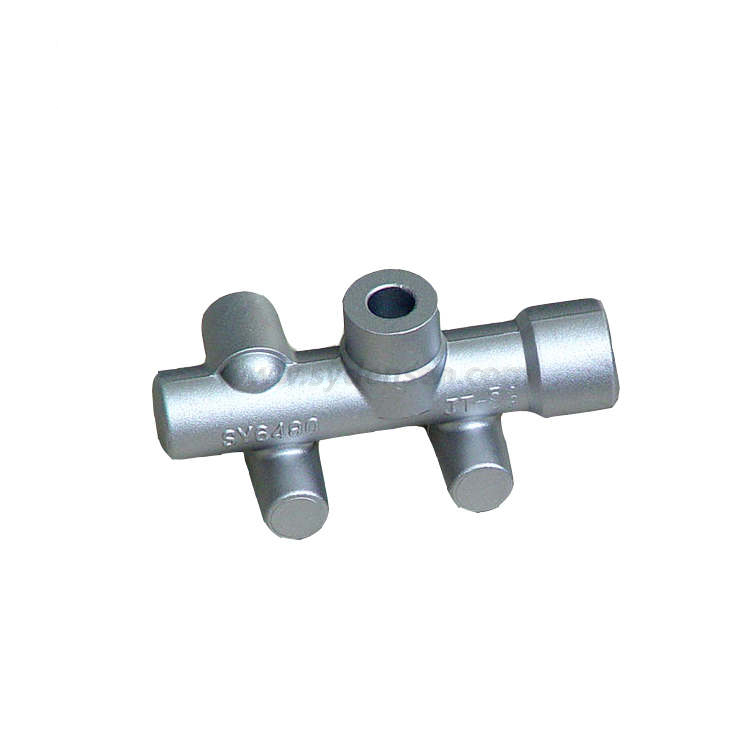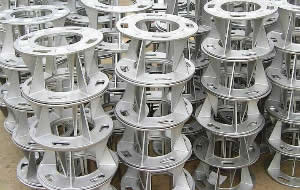Common Challenges in aluminum casting and Practical Solutions Explained
Aluminum Casting Explained: Key Facts and Insights for Sector Professionals
Aluminum casting works as a crucial process in contemporary manufacturing, forming parts across various fields. Its varied approaches, such as sand and die casting, deal with various manufacturing needs. The unique residential or commercial properties of aluminum alloys boost their applicability, yet tests continue to be in preserving quality and effectiveness. Understanding these facets is vital for market specialists. What are the most up to date innovations and best methods that can better maximize this procedure?
Review of Aluminum Casting Processes

Crucial element of aluminum casting processes include the prep work of mold and mildews, which may be made from sand, metal, or ceramic materials, depending upon the meant use. Furthermore, temperature control is crucial to assure proper melting and solidification of aluminum.
The casting procedure enables intricate styles and can attain high levels of dimensional accuracy. Once cooled, the castings may go through finishing procedures such as machining or surface treatment to satisfy certain performance standards. On the whole, aluminum casting works as a functional production technique, effectively satisfying the diverse needs of numerous markets.
Kinds Of Aluminum Casting Approaches
In the domain name of aluminum casting, different methods are employed to achieve different results. Sand casting techniques supply versatility and cost-effectiveness for complicated forms, while die casting processes supply high accuracy and effectiveness for mass production. Understanding these approaches is crucial for picking the ideal method based upon task requirements.
Sand Casting Strategies
Sand casting methods represent a fundamental method in aluminum casting, where sand is made use of as a mold product to shape liquified steel. This procedure entails creating a pattern from the desired component, which is then positioned in a sand mixture to form a mold. The sand is compacted around the pattern, and after elimination, it develops a cavity in the form of the part. Molten aluminum is put right into this tooth cavity, permitting it to cool and solidify. One substantial advantage of sand casting is its convenience; it can suit complicated forms and big parts. Furthermore, the materials used are relatively economical, making it an obtainable option for numerous manufacturing applications in the aluminum market.
Die Casting Processes
Die casting procedures are a noticeable method for shaping aluminum elements, using high-pressure techniques to compel molten metal into exactly crafted mold and mildews. This process is specifically favored for its capacity to generate complex forms with tight resistances and a smooth finish. There are 2 key types of die casting: warm chamber and chilly chamber. Warm chamber die casting appropriates for steels with low melting points, enabling faster production prices. Conversely, cold chamber die casting is ideal for higher melting factor steels, calling for a separate melting heating system. Both techniques enhance performance and lower material waste, making them vital in vehicle, aerospace, and customer items industries. Comprehending these procedures assists specialists pick the most ideal method for their specific applications.
Material Quality of Aluminum Alloys

Strength and Resilience
Strength and sturdiness are crucial characteristics of aluminum alloys that make them appropriate for different casting applications. These materials display a favorable strength-to-weight proportion, permitting for the development of lightweight yet durable components. When it come to tensile stamina, details aluminum alloys can be crafted to endure considerable tons without deforming. This residential property is especially vital in sectors such as aerospace and vehicle, where performance and safety are extremely important. In addition, aluminum alloys usually retain their mechanical properties under varied temperature level conditions, guaranteeing constant efficiency. The innate ductility of these alloys also enables effective shaping throughout the casting procedure, making it much easier to produce complex geometries. In general, the strength and resilience of aluminum alloys add substantially to their prevalent use in innovative applications.
Corrosion Resistance Characteristics
While aluminum alloys are prized for their strength and lightweight properties, their corrosion resistance is an additional vital attribute that improves their viability for numerous applications. Aluminum normally creates a safety oxide layer when subjected to moisture, which helps to stop additional oxidation. This intrinsic residential or commercial property makes aluminum alloys particularly beneficial in atmospheres prone to rust, such as commercial and aquatic setups. Furthermore, various alloy make-ups can influence resistance degrees, with specific alloys especially engineered to enhance this particular. Therapies like anodizing can even more enhance rust resistance by enlarging the oxide layer. Comprehending the deterioration resistance of aluminum alloys is necessary for market experts when selecting materials for tasks calling for sturdiness and durability in difficult settings.
Advantages of Aluminum Casting in Manufacturing
Aluminum casting deals countless benefits in production, making it a preferred option for numerous industries. One substantial benefit is its lightweight nature, which adds to reduced transportation expenses and boosted energy performance in final result. Aluminum's superb thermal and electrical conductivity improves performance in applications requiring warmth dissipation or electric conduction.
The material's capability to be cast right into detailed shapes permits style adaptability, lowering the demand for additional machining processes. Additionally, aluminum casting exhibits superior rust resistance, leading to longer product life-spans and lower maintenance costs.

Common Applications of Aluminum Castings
The flexibility of aluminum casting allows content its widespread use across numerous sectors. Common applications consist of auto parts, where light-weight and corrosion-resistant components, such as engine blocks and transmission real estates, enhance automobile efficiency. In the aerospace industry, aluminum spreadings are made use of for structural parts, offering stamina without adding substantial weight.
In addition, the electric sector benefits from aluminum castings in manufacturing units and warm sinks, where thermal conductivity is crucial. The customer goods sector likewise integrates aluminum spreadings in products like cooking equipment, furniture, and decorative things, combining appearances with performance.
Additionally, the building and construction market employs aluminum spreadings for architectural components, window frameworks, and fixtures, which offer resilience and style versatility. On the whole, the varied applications of aluminum spreadings emphasize their importance in modern manufacturing, contributing to improvements in effectiveness and product style across several areas.
Technologies and Technical Innovations
As markets proceed to advance, advancements in aluminum casting modern technology are changing manufacturing procedures and product capacities. Innovations in 3D printing and additive production have enabled the production of intricate geometries that were formerly impossible to achieve with traditional techniques. These innovations enable for rapid prototyping, minimizing preparations and costs.
In addition, improvements in mold style and products have actually boosted the casting procedure by raising efficiency and reducing waste. The combination of wise manufacturing methods, such as IoT devices and real-time data analytics, enables better monitoring and optimization of manufacturing criteria, resulting in higher quality outcomes.
In addition, growths in aluminum alloys provide boosted strength, deterioration resistance, and lightweight properties, satisfying the growing demands in aerospace and vehicle fields. Collectively, these innovations are not only enhancing efficiency but likewise satisfying the strenuous standards of modern design applications.
Ideal Practices for Quality Assurance in Aluminum Casting
Making sure high-grade outcomes in aluminum casting requires adherence to best practices that include different stages of the production process. First, detailed product inspection is necessary to confirm the high quality of aluminum alloys used, as contaminations can considerably affect the end product. Implementing precise melting and putting strategies reduces flaws; keeping perfect temperatures stops oxidation and advertises harmony.
Furthermore, mold and mildew style plays an important role; making use of computer-aided design (CAD) can boost accuracy and lower human mistake. Normal tracking of the cooling process is crucial to stay clear of bending and shrinking. Additionally, making use of non-destructive testing approaches, such as ultrasonic or X-ray evaluations, assists determine internal imperfections without harming the elements.
Lastly, establishing a feedback loophole with engineers and operators cultivates constant improvement, making certain that quality control measures develop alongside technical innovations. By complying with these ideal techniques, manufacturers can enhance the reliability and efficiency of aluminum castings.
Often Asked Concerns
What Are the Environmental Influences of Aluminum Casting?
The environmental effects of aluminum casting consist of substantial power intake, greenhouse gas exhausts, and prospective water contamination from factory procedures. Additionally, bauxite mining for aluminum ore can result in habitat destruction and soil destruction.
Just How Does Aluminum Casting Compare to Various Other Steel Casting Procedures?
Aluminum casting generally supplies benefits in light-weight components and deterioration resistance contrasted to various other procedures, such as iron or steel casting, which might provide higher toughness however result in larger and much less corrosion-resistant products. - Precision aluminum casting
What Prevail Flaws in Aluminum Castings and Their Causes?
Typical issues in aluminum spreadings consist of porosity, shrinking, and inclusions. Reasons frequently stem from more info here inappropriate putting techniques, inadequate mold layout, or contamination of the liquified steel, impacting the last product's honesty and efficiency.
What Security Preventative Measures Should Be Taken Throughout Aluminum Casting?
Throughout aluminum casting, essential safety precautions include wearing safety equipment, guaranteeing appropriate air flow, read the article keeping a tidy office, managing molten steel with treatment, and following well-known procedures to decrease threats of burns, breathing threats, and accidents.
How Can I Improve the Effectiveness of My Aluminum Casting Procedures?
To improve efficiency in aluminum casting procedures, one must optimize mold and mildew style, streamline material handling, use automated procedures, perform normal maintenance on tools, and purchase staff member training to enhance skills and performance.
Various techniques exist, aluminum casting incorporates numerous primary processes that provide to different applications and needs. Secret elements of aluminum casting processes consist of the prep work of molds, which might be made from sand, steel, or ceramic materials, depending on the intended usage. Sand casting techniques represent a fundamental technique in aluminum casting, where sand is utilized as a mold product to form liquified steel. As industries continue to develop, technologies in aluminum casting innovation are transforming production procedures and item capabilities. Guaranteeing high-quality outputs in aluminum casting calls for adherence to best practices that encompass numerous stages of the manufacturing procedure.